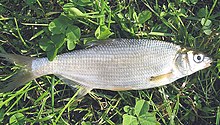
The ide, or orfe, is a freshwater fish of the family Cyprinidae found in larger rivers, ponds, and lakes across Northern Europe and Asia. It has been introduced outside its native range into Europe, North America, and New Zealand. It is a popular ornamental fish, usually kept in outdoor ponds in temperate regions from which it often escapes.

The zebra shark is a species of carpet shark and the sole member of the family Stegostomatidae. It is found throughout the tropical Indo-Pacific, frequenting coral reefs and sandy flats to a depth of 62 m (203 ft). Adult zebra sharks are distinctive in appearance, with five longitudinal ridges on a cylindrical body, a low caudal fin comprising nearly half the total length, and usually a pattern of dark spots on a pale background. Young zebra sharks under 50–90 cm (20–35 in) long have a completely different pattern, consisting of light vertical stripes on a brown background, and lack the ridges. This species attains a length of 2.5 m (8.2 ft).

The bluegill, sometimes referred to as "bream," "brim," "sunny," or "copper nose" as is common in Texas, is a species of North American freshwater fish, native to and commonly found in streams, rivers, lakes, ponds and wetlands east of the Rocky Mountains. It is the type species of the genus Lepomis, from the family Centrarchidae in the order Perciformes.
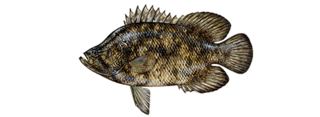
The Atlantic tripletail or tripletail is a warm-water marine fish found across the tropics; it can grow to 90 cm long and weigh 18 kg. It is also known by fishermen by names like flasher or steamboat. Young fishes float on their sides, often beside flotsam, and appear like a dry leaf.
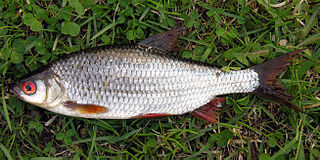
The roach, or rutilus roach, also known as the common roach, is a fresh- and brackish-water fish of the family Cyprinidae, native to most of Europe and western Asia. Fish called roach can be any species of the genera Rutilus and Hesperoleucus, depending on locality. The plural of the term is also roach.

The common bleak is a small freshwater coarse fish of the cyprinid family.

The alfonsino, also known as the alfonsin, longfinned beryx, red bream, or imperador, is a species of deepwater berycid fish of the order Beryciformes. It can be found in temperate and subtropical ocean waters nearly worldwide, though it is uncommon. It is typically associated with deep-sea corals, and schools are known to form over seamounts. Adults are demersal and search for prey along the ocean floor, primarily fish, cephalopods, and crustaceans. Like other members of its family, it is remarkably long-lived, with individuals reaching ages of up to 69 years, and possibly longer. It can reach sizes of up to 1 m (3.3 ft) in length and 2.5 kg (5.5 lb) in weight and is targeted by commercial fisheries. Its low reproductive rate and the time it takes for juveniles to mature make it vulnerable to expanding deep-sea fisheries, but it is listed as Least Concern by the International Union for Conservation of Nature (IUCN) due to its extensive range.
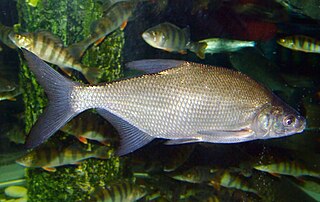
The common bream, also known as the freshwater bream, bream, bronze bream, carp bream or sweaty bream, is a European species of freshwater fish in the family Cyprinidae. It is now considered to be the only species in the genus Abramis.

Frogfishes are any member of the anglerfish family Antennariidae, of the order Lophiiformes. Antennariids are known as anglerfish in Australia, where the term "frogfish" refers to members of the unrelated family Batrachoididae. Frogfishes are found in almost all tropical and subtropical oceans and seas around the world, the primary exception being the Mediterranean Sea.
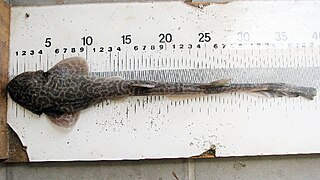
The Izak catshark or simply Izak is a species of catshark, belonging to the family Scyliorhinidae, common off the coasts of South Africa and southern Namibia. It typically inhabits the outer continental shelf at depths of 100–300 m (330–980 ft), with the males found deeper than the females and juveniles. The Izak catshark has a short, wide, flattened head and a robust body tapering to a long, slender tail. It can be identified by its ornate color pattern of dark brown spots or reticulations and blotches on a light yellowish background, as well as by the enlarged dermal denticles over its pectoral fins and along its dorsal midline from the snout to the second dorsal fin. This species reaches 69 cm (27 in) in length, with the males larger than females.

The quagga catshark is a species of catshark, belonging to the family Scyliorhinidae. A small, slim-bodied shark reaching 37 cm (15 in) in length, it has a distinctive color pattern of narrow, dark brown vertical bars, which resemble those of the quagga. Its head is short and flattened, with a pointed snout tip that is not upturned.

The cloudy catshark is a common species of catshark, belonging to the family Scyliorhinidae. It is a bottom-dweller that inhabits rocky reefs in the northwestern Pacific Ocean, from the shore to a depth of 320 m (1,050 ft). Growing up to 50 cm (20 in) long, this small, slim shark has a narrow head with a short blunt snout, no grooves between the nostrils and mouth, and furrows on the lower but not the upper jaw. It is also characterized by extremely rough skin and coloration consisting of a series of dark brown saddles along its back and tail, along with various darker and lighter spots in larger individuals.

The longfin sawtail catshark is a rare, little-known species of catshark, part of the family Scyliorhinidae. Once thought to be a subspecies of the roughtail catshark along with the Antilles catshark, it inhabits deep water off the Caribbean coasts of Panama and Colombia. This slim-bodied species has a marbled dorsal color pattern and a prominent crest of enlarged dermal denticles along the dorsal edge of its caudal fin. It can be distinguished from similar species by its relatively longer anal fin and small adult length of under 35 cm (14 in). The longfin sawtail catshark is oviparous.

The gecko catshark is a species of catshark, part of the family Scyliorhinidae, native to the northwestern Pacific Ocean from southern Japan to Taiwan, and possibly also off Vietnam. It is a common, demersal species found at depths of 100–900 m (330–2,950 ft). Its body is slender, with a pattern of dark saddles and blotches. The dorsal and caudal fins are edged in white, and there is a prominent crest of enlarged dermal denticles along the dorsal edge of the caudal fin. The gecko catshark is a schooling, opportunistic predator of bony fishes, cephalopods, and crustaceans. It is oviparous, with females producing two vase-shaped egg capsules at a time. This species is captured as bycatch, but does not appear to be threatened by fishery activities at present and has been assessed as Least Concern by the International Union for Conservation of Nature (IUCN).

The broadfin sawtail catshark is a common species of catshark, part of the family Scyliorhinidae. It is found on or near the bottom at depths of 150–540 m (490–1,770 ft), from southeastern Japan to the East China Sea. A slender species growing to 68 cm (27 in) long, this shark is characterized by a fairly long, pointed snout, a series of indistinct, dark saddles along its back and tail, and a prominent crest of enlarged dermal denticles along the dorsal edge of its caudal fin. In addition, adult males have very long claspers that reach past the anal fin. The broadfin sawtail catshark is an opportunistic predator of bony fishes, cephalopods, and crustaceans, with immature and mature sharks being primarily piscivorous. It is oviparous and reproduces year-round.

The Arabian carpetshark is a species of carpet shark in the family Hemiscylliidae, inhabiting coral reefs and other shallow coastal habitats from the Persian Gulf to India. Reaching 78 cm (31 in) long, this shark is characterized by a slender, plain brown body, and by two dorsal fins with straight trailing margins and the second smaller but longer-based than the first. The Arabian carpetshark feeds on bony fishes and invertebrates. Reproduction is oviparous with an annual cycle; females deposit egg capsules four at a time and the young hatch after 70–80 days. This small shark is often captured as bycatch but rarely used by humans. It has been assessed as Near Threatened by the International Union for Conservation of Nature (IUCN), as there is increasing fishing pressure and habitat degradation within its range. It does well in aquariums and has been bred in captivity.
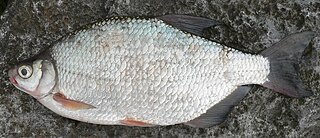
Blicca bjoerkna, alternatively called the white bream or the silver bream, is a European species of freshwater fish in the family Cyprinidae.

Lagodon is a genus of saltwater fish in the family Sparidae, the breams and porgies. It is monotypic, being represented by the single species Lagodon rhomboides, commonly known as pinfish. Other common names include pin perch, sand perch, choffer, and butterfish. It inhabits mostly subtropical shallow coastal waters of the Atlantic and Gulf coasts of the United States and Mexico.
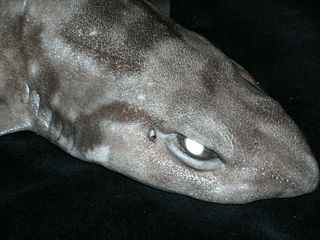
Scyliorhinus meadi, the blotched catshark, is a little-known species of catshark, and part of the family Scyliorhinidae, found in the western central Atlantic Ocean. It inhabits banks of deep-sea coral at depths of 329–548 m (1,079–1,798 ft), feeding on cephalopods, shrimp, and bony fishes. This species can be identified by its wide body and head, and the dark saddle-like markings on its back. It also has small spots that fluoresce yellow under a blue light. Adult blotched catsharks have not been observed; the largest immature specimen is 49 cm (19 in) long. Like other catsharks, it is believed to be oviparous. This species is not dangerous to humans and has no commercial significance.
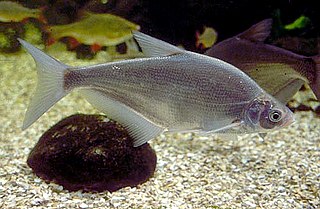
Ballerus ballerus, also known as the zope or the blue bream, is a species of cyprinid fish native to Eurasia.
